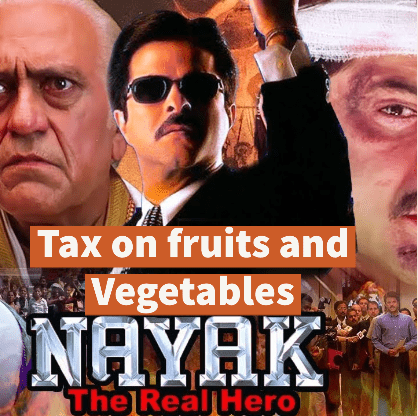Movie Case Study
Shivaji Rao (played by Anil Kapoor) is the state’s chief minister. The scene shows Shivaji Rao disguised as a truck driver to check the current situation in the market. He finds out that he is being asked to pay taxes on vegetables, a necessity good.
In this blog, Learning Perspectives will explore whether tax is imposed on fruits and vegetables.
GST on Vegetables – What are the Rules?
Do I have to pay GST on fresh vegetables? Yes, fresh produce is subject to GST.
On average, each person consumes at least 2 vegetables and 1.5 fruits per day which is effective in terms of demand, supply, and consumption of the necessities. Let’s find out how much tax does your normal plate of food cost?
GST and Its Tax Slabs
Goods and Service Tax or GST came into existence in 2010 in the Lok Sabha meeting, proposed as a common tax on products and services. But due to political reforms, it was amended on 1st September 2016 which was the 101st Constituent Amendment Act.
The concept of GST was first introduced in France, and later almost 160 countries across the globe adopted it too. In India, it is solely managed by the GST Network (GSTN).
The Indian government has categorized over 1300 products and 150+ services under 5 different tax slabs that are as follows
- NIL
- 5%
- 12%
- 18%
- 28%
All these tax slabs are formed to clarify the necessity and luxury state of a product or service offered to a consumer. In addition to this, fruits and vegetables are part of the necessary goods. Do they come under any dedicated tax slab?
TAX IMPOSED ON FRUITS AND VEGETABLES?
The government of India has verified the fruits and vegetables with HSN (Harmonized System of Nomenclature) codes that are segregated into 3 different tax slabs. By not imposing a tax of more than 12% on any of the fruits/vegetable items rolling in the market.
Whereas, sellers or vendors who sell through online portals have to pay the charges of listing their product or paying a GST of not more than 12% on selected fruit items.
GST Act was clear with its goals to serve a vast population with a tax-free policy in the country as a result it imposed no tax on the necessary goods consumed by a vast population. Few items in fruit categories are still marked under 5-12% of the category. Whereas, all vegetables are charged at nil or 5% GST tax slabs and are sold without taxes.
Vegetables that attract 5% GST:
- Herb, bark, and dark plant.
- Frozen Vegetables
- Preserved Vegetables
- Artichokes, arrowroot, and sweet potatoes are starchy and have high insulin content, dried and frozen.
All other vegetables are exempt from GST.
Fruits under the Nil slab include the following:
Fresh fruits (not kept preserved), bananas, melons, papaya, strawberries, Apples, Apricots, Citrus fruits, Dates, and fresh Nuts like; Almonds, Hazelnuts, Walnuts, etc.
Fruits under 5% slab:
Dried nuts, Frozen fruits, peel of citrus fruits (kept frozen), and preserved fruits that are unsuitable for immediate consumption.
Fruits under 12% slab:
Imported fruits and nuts: grapes, dried raisins, Cooked & served fruits with added preservatives, and dried nuts, whether or not shelled/peeled.
Conclusion:
Now you know the reason why some fruits are more expensive than others. However, vegetables are exempt from tax. You can now figure out, the tax imposed on your next meal. Nutritionists say those who eat well, live longer as compared to those who avoid eating fruits and vegetables. Let’s eat and spend money mindfully.








